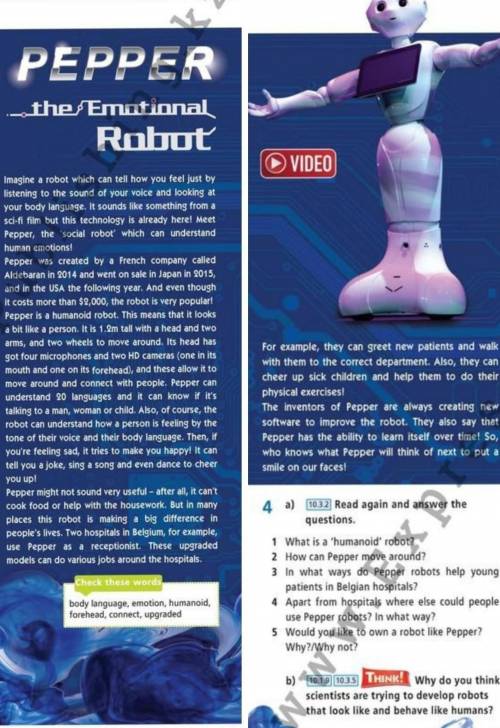Read again and answer the questions. 1 What is a "humanoid' robot
2 How can Pepper move around?
3 In what ways do Pepper robots help young patients in Belgian hospitals?
4 Apart from hospitals where else could people use Pepper gobots? in what way?
5 Would you ike to own a robot like Pepper? Why?/Why not?

Другие вопросы по теме Английский язык
Популярные вопросы
- Переведите на : 1.они потеряли надежду найти свою собаку. 2.я...
1 - Из двух пунктов навстречу друг другу одновременно выехали два...
2 - Велосепедист с одинаковой скоростью в первый день проехал 65...
2 - Впервый день на покраску скамеек в парке по тратили 4 банки краски...
3 - Какова твердость глюкозы по относительной шкале мооса...
3 - Реши . составь и реши . а) в одной коробке 6 машинок. сколько...
3 - За 3 часа опытный рыбак поймал 24 рыбы, а его сын за это же время...
1 - Напишите сочинение- рассуждение на тему время, в которое я живу...
1 - Выполните действия : (1 3/5+1,8)*1/2...
1 - Скакой целью для разных карт используют разные картографические...
1
To answer this question, we need to go back to the text and find information about what a humanoid robot is. We can look for keywords such as "humanoid" and "robot." Going through the text, we find that the article mentions Pepper as an example of a humanoid robot. Based on this information, we can conclude that a "humanoid" robot is a robot that resembles or imitates human behavior and appearance.
2) Pepper can move around using wheels on its base. The wheels allow Pepper to move in any direction. It can move forward, backward, and sideways. Pepper's movement is controlled by a combination of software and sensors, which enable it to navigate its surroundings and avoid obstacles.
To answer this question, we need to find information about how Pepper can move around. The text mentions that Pepper has wheels on its base, which allow it to move. It also mentions that Pepper's movement is controlled by software and sensors. Based on this information, we can conclude that Pepper moves around using wheels on its base, and its movement is controlled by software and sensors.
3) Pepper robots help young patients in Belgian hospitals in several ways. They can engage with children by speaking and interacting with them. Pepper can play games, tell stories, and even dance with the children. This helps to create a friendly and interactive environment for the young patients, distracting them from their medical conditions and providing them with emotional support. Moreover, Pepper can also provide information, answer questions, and guide the children to different areas within the hospital.
To answer this question, we need to find information about how Pepper robots help young patients in Belgian hospitals. The text mentions that Pepper can engage with children by speaking and interacting with them, play games, tell stories, and even dance with them. It also mentions that this helps to create a friendly and interactive environment and provide emotional support. Additionally, it mentions that Pepper can provide information, answer questions, and guide the children. Based on this information, we can conclude that Pepper robots help young patients in Belgian hospitals by engaging with them, providing emotional support, and assisting with information and guidance.
4) Apart from hospitals, people could use Pepper robots in various other settings. For example, in retail stores, Pepper can greet customers, provide information about products, and even assist with payment transactions. In hotels, Pepper can serve as a receptionist, answering guest inquiries and providing directions. In schools, Pepper can facilitate interactive learning by delivering educational content and engaging with students. Additionally, Pepper can be used in homes as a personal assistant, helping with tasks such as scheduling, reminders, and entertainment.
To answer this question, we need to find information about where people could use Pepper robots apart from hospitals. The text mentions some potential uses of Pepper in retail stores, hotels, schools, and homes. In retail stores, Pepper can greet customers and provide information. In hotels, Pepper can serve as a receptionist. In schools, Pepper can facilitate interactive learning. In homes, Pepper can act as a personal assistant. Based on this information, we can conclude that Pepper robots could be used in various settings, including retail stores, hotels, schools, and homes.
5) Whether someone would like to own a robot like Pepper would depend on personal preferences and needs. Some people might like the idea of having a robot companion that can assist with tasks, provide entertainment, and offer companionship. Others might not be interested in owning a robot and prefer human interactions and assistance. It is important to consider the benefits and limitations of owning a robot, such as the cost, maintenance, and the potential impact on human relationships.
To answer this question, we need to express our own opinion about owning a robot like Pepper and provide reasons for our preference. This is a subjective question, so there is no right or wrong answer. It is important to consider personal preferences, needs, and the potential impact of owning a robot.